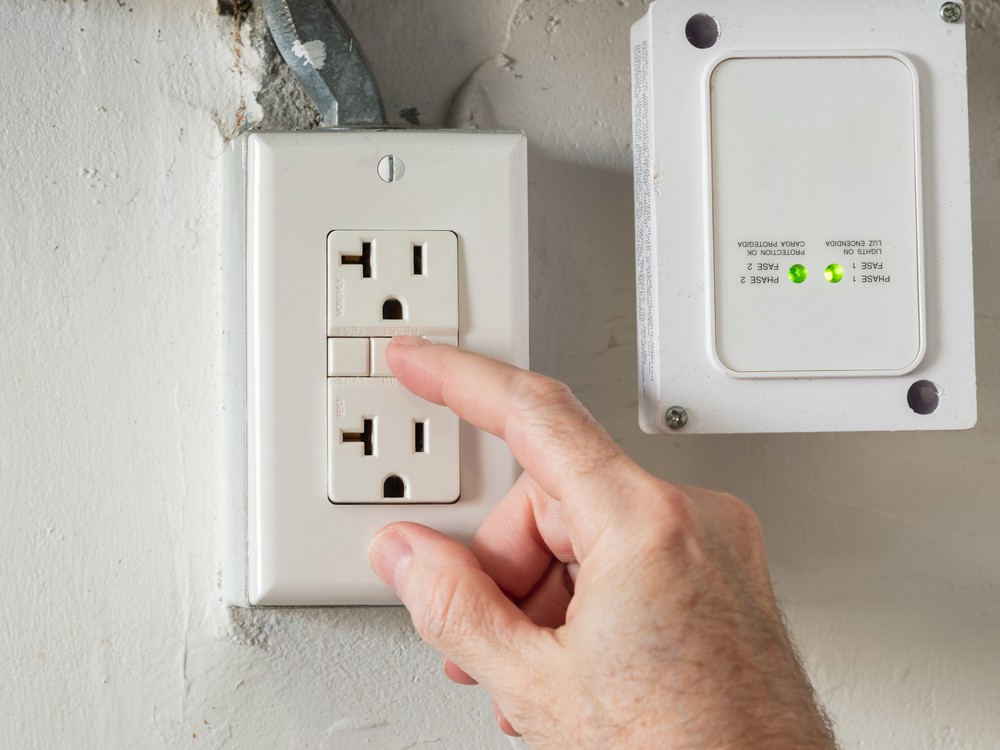A GFCI stands for Ground Fault Circuit Interrupter. GFCIs can also be referred to as GFIs, or Ground Fault Interrupters. A GFCI is a type of electrical outlet that is designed to protect people from electric shock. It works by monitoring the electrical current flowing through the circuit, and automatically cutting off power to the outlet if it detects any deviation when a ground fault occurs. The GFCI outlet comes with a Test and Reset button built into the outlet.
To simplify it, a GFCI is a type of outlet that greatly protects people from electricity flowing to whatever appliance or device is plugged in.
A GFCI outlet has a built-in sensor that detects the difference in the amount of current flowing into the outlet and the amount of current flowing out of the outlet. If there is any difference in the current flow, it indicates that some of the current is leaking out of the circuit and could potentially be flowing through a person's body, which could cause electric shock.
When the GFCI outlet detects a current leak it immediately shuts off power to the outlet, stopping the flow of electricity and preventing any further potential electric shock. All of this happens within a fraction of a second.
What is a Ground Fault?
If you've ever had that momentary shock when plugging a device into an outlet you were an element in something called a ground fault.
A ground fault occurs when an electrical current is diverted from its intended path and instead flows through an unintended path, such as through a person's body, through water, or numerous other conductive means. This can happen when a live wire comes in contact with a grounded object or a person, which can lead to electric shock or even electrocution. Usually this occurs due to damaged wiring insulation. Sometimes this happens from environmental factors, an aged wire, or even a rodent chewing through the wire.
What Did People Do Before GFCIs?
Before GFCIs were invented, there was no effective way to protect people from ground faults, which occur when an electrical current finds an unintended path to the ground. Ground faults can cause electrical shocks and electrocution, which can be fatal. Around 800 people in the US died every year before the invention of GFCIs.
In the past, people relied on circuit breakers and fuses to protect against electrical hazards, but these devices are designed to protect against overloading and short circuits, not ground faults. While these devices can help prevent electrical fires and other hazards, they do not provide the same level of protection as GFCIs.
GFCIs became available in the 1960s and were developed with a fast response time to help prevent electrical shocks and electrocution, making GFCIs an important safety feature in any building where electrical equipment is used.
Today, GFCIs are required by code in certain areas of homes and buildings, such as kitchens, bathrooms, and outdoor areas. They are also commonly used in commercial and industrial settings to protect workers and equipment from electrical hazards.
A great example of the benefit of GFCIs is that if someone were to plug in an appliance the GFCI outlet will monitor the amount of electricity going to this appliance. If for some reason the appliance is dropped into water, the GFCI will detect this and immediately cut the power, preventing electrocution.
Why are GFCIs a Safer Outlet Option?
GFCI use in commercial buildings is important to ensure the safety of employees, customers, and visitors. GFCIs are typically required by code in certain areas of commercial buildings where electrical equipment is used such as:
- Bathrooms
- Kitchens
- Laundry and utility rooms
- Spa, pool areas, or anywhere near water
In addition to these specific areas, GFCIs can also be installed in other areas of a commercial building where additional protection is desired. For example, GFCIs can be installed in areas where electrical equipment is used in close proximity to people, such as conference rooms, break rooms, or workspaces.
GFCIs also provide protection against overloading, which can occur when too many electrical devices are plugged into a single outlet or circuit. Overloading can cause electrical fires or other hazards, but GFCIs can help prevent these issues by interrupting the flow of electricity when an overload occurs.
Intricacies of the GFCI in a Commercial Building
The requirements for outlets inside a commercial building are more stringent than for a residential structure. For example, in a commercial kitchen, every 15- or 20-amp, 120-volt outlet must be a GFCI, not just the ones on the countertops or near a wet area. As in residential buildings, all bathroom outlets must be GFCIs, as well as those on rooftops or in basements. If the commercial building has a workshop, every outlet in it must have ground-fault protection, as it would if the workshop were in a residential building.
Regular maintenance and testing of GFCIs is also important in commercial buildings to ensure that they are functioning properly and providing adequate protection. This can include monthly testing of GFCI outlets using the test button, and periodic inspections by a qualified electrical engineer or technician.
Overall
GFCI devices are important safety features that are designed to protect people from electrical shocks and electrocution. Improper installation of GFCI devices can result in ineffective protection and can even create new safety hazards.
Here at MTA Electrical Engineers, we have experienced engineers and technicians who have the knowledge, skills, and tools to test GFCI devices correctly and safely. We can ensure that the devices are installed in the appropriate locations, are properly wired, and are functioning as intended. We can also provide guidance on the proper use and maintenance of the devices. Contact MTA today for professional electrical testing services in California.

